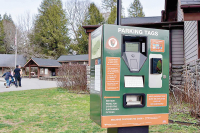The unique habitat of mountain streams
 The creeks and streams of the Southern Highlands are one of the most exciting natural areas we have. Unlike most upland habitats — which generally occur as blocks or patches or elevational zones — streams form winding corridors that afford varied niches for plants and animals that can’t adapt to a linear lifestyle.
The creeks and streams of the Southern Highlands are one of the most exciting natural areas we have. Unlike most upland habitats — which generally occur as blocks or patches or elevational zones — streams form winding corridors that afford varied niches for plants and animals that can’t adapt to a linear lifestyle.
Within the water there’s a variety of animal life, ranging from sparkling trout to sleek otters to grotesque hellbenders to water shrews equipped with hairy feet that allow them to hunt underwater. In quiet pools and eddies, waterstriders skate on an invisible film provided by surface tension. Dragonflies stake out well-defined territories along the water corridor. Louisiana waterthrushes hunt for worms and snails in streamside debris they take to their young hidden away in nests built under overhanging banks.
Within the spray zones of waterfalls and cascades is the shimmering emerald world of the mosses, liverworts, ferns, and other moisture-loving plants like umbrella leaf and branch lettuce.
Then, somewhat farther back — in the miniature floodplains or wash zones created by periodic overflows — a variety of trees, shrubs,and herbaceous plants form tangles that define the outer edges of the corridor.
The signature plant and animal species for this serpentine, aqueous, ever-moving habitat are belted kingfishers and shrub yellowroot.
One of the most distinctive plants in the Blue Ridge, yellowroot occurs along the banks of most streams. Look for a woody plant about 8- to 24-inches high that resembles a miniature palm tree; that is, all the leafy green growth is at the top of the stem. Attractive tassels of maroon flowers appear as early as February.
Related Items
Yellowroot has devised strategies for growth and seed dispersal in areas periodically invaded by overflow. They almost always form colonies with integrated root systems that help the plant maintain a foothold when flooding occurs. Another flood-disaster prevention feature is the bare flexible stem that offers little resistance to raging water. And the fruits produced in summer disperse seeds that float away on inflated capsules.
During the breeding season, a pair of belted kingfishers establish themselves along several miles of the small creek that flows through our property. They are my favorite birds, so much so that 35 or so years ago I wrote a poem titled “Kingfisher’s Return”:
For days now you have been watching
and waiting … but not ‘til you are least
prepared is she suddenly there: sculling
upstream with swift strokes, rattling
the morning into being as she weaves
her territory with sound and paints the air
blue-gray and rust-brown as her kind
has for so many thousand years.
Beyond all thinking she is attuned to a
fuller world than you or I will ever know.
Intuitive gardener of the bright air she
hovers on blurred wings before suddenly
disappearing in the magic water.
George Ellison wrote the biographical introductions for the reissues of two Appalachian classics: Horace Kephart’s Our Southern Highlanders and James Mooney’s History, Myths, and Sacred Formulas of the Cherokees. In June 2005, a selection of his Back Then columns was published by The History Press in Charleston as Mountain Passages: Natural and Cultural History of Western North Carolina and the Great Smoky Mountains. Readers can contact him at P.O. Box 1262, Bryson City, N.C., 28713, or at This email address is being protected from spambots. You need JavaScript enabled to view it..









